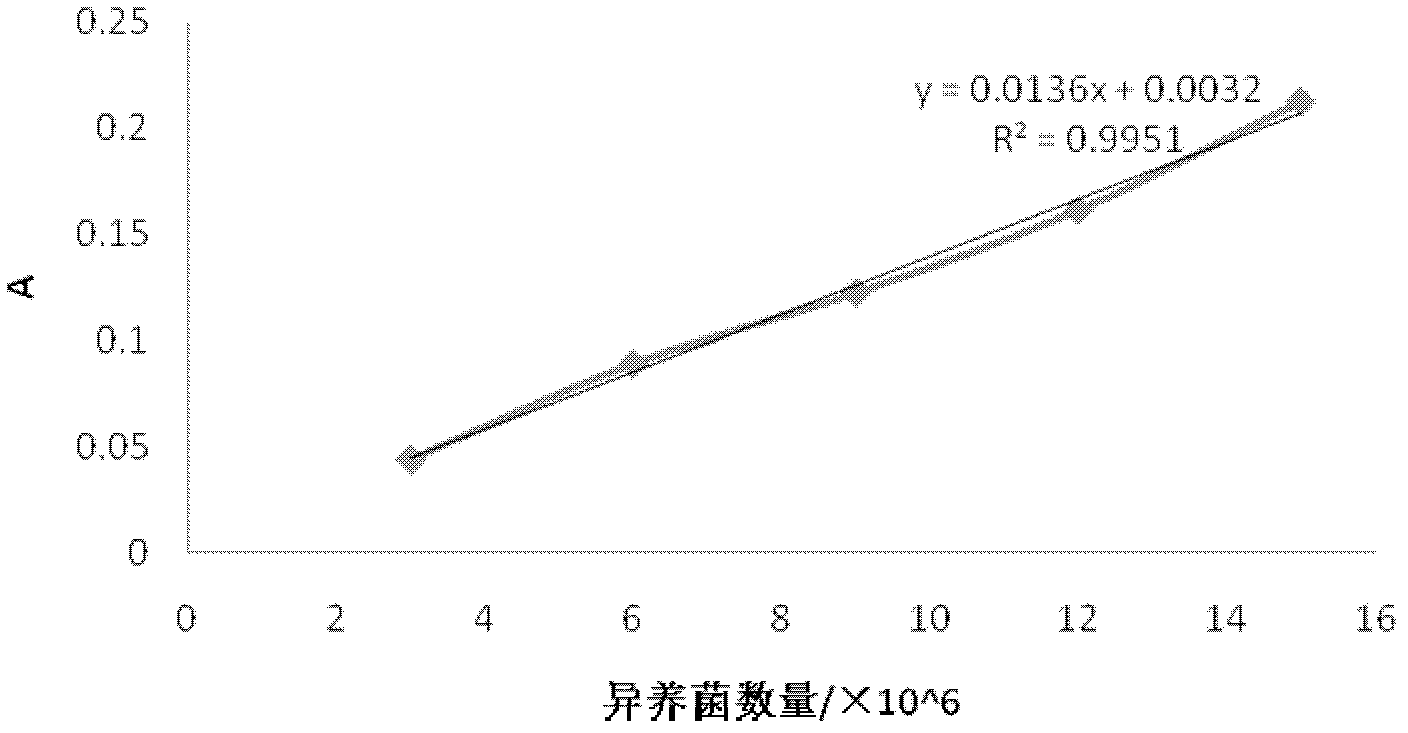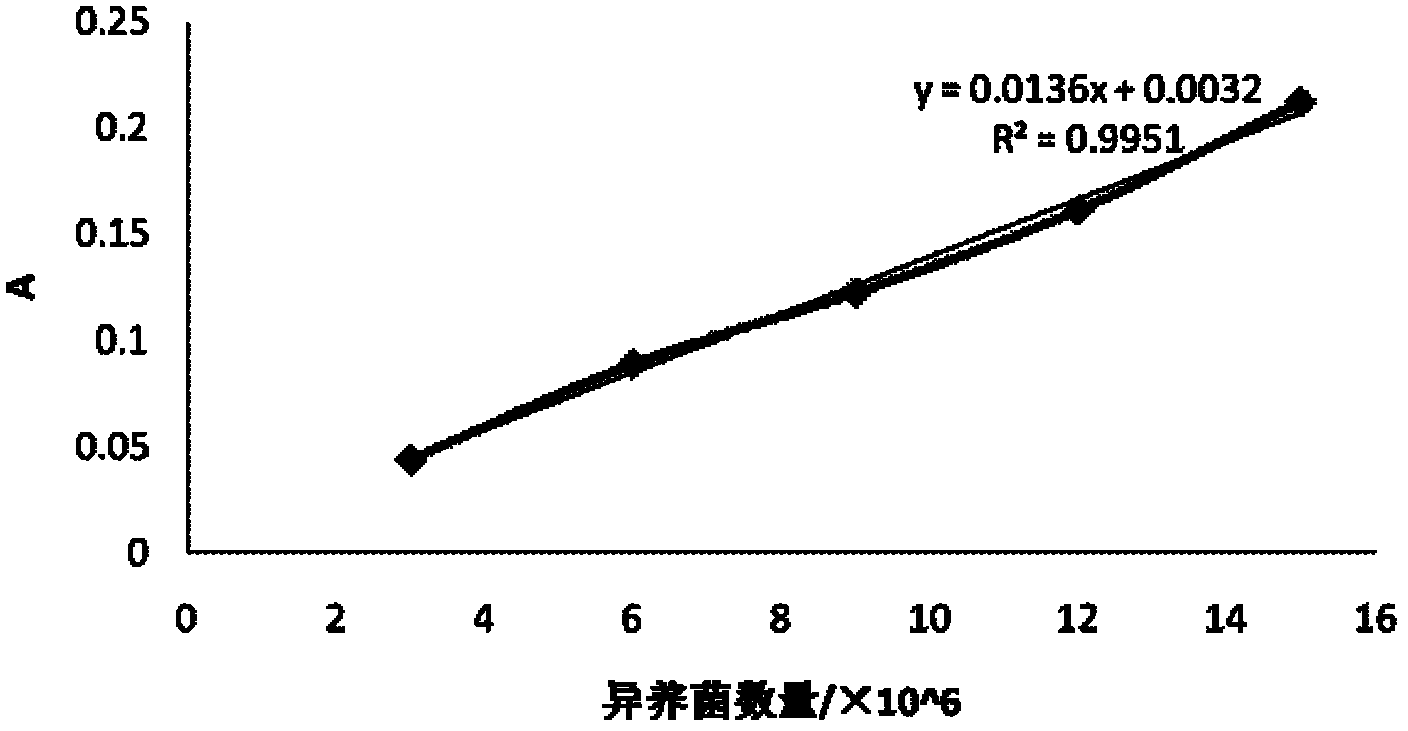Method for detecting heterotrophic bacteria content of industrial circulating water
A technology for industrial circulating water and heterotrophic bacteria, applied in the field of detection, can solve the problems of long measurement time, unfavorable monitoring of the water quality of circulating cooling water, etc. Effect
- Summary
- Abstract
- Description
- Claims
- Application Information
AI Technical Summary
Problems solved by technology
Method used
Image
Examples
Embodiment 1
[0024] Prepare the reagents needed for the experiment:
[0025] Ninhydrin reagent: dissolve 0.6g fructose and 1.0g ninhydrin in 100ml distilled water, store in brown volumetric flask;
[0026] pH buffer preparation: pH=5.9, 45ml 1 / 15mol / 1 potassium dihydrogen phosphate solution and 5ml 1 / 15mol / l disodium hydrogen phosphate solution;
[0027] Accurately prepare 1.00mol / l NaOH solution and 1.00mol / l HCl solution according to the standard method;
[0028] The volume of circulating water is 100ml (the source of the water sample is the circulating cooling water used in the refinery)
[0029] a) The water sample is filtered, and the bacteria in the water sample are enriched on a microporous filter membrane made of nylon material with a filter membrane pore size of 0.22 μm;
[0030] b) Transfer the bacteria-enriched carrier to 5 ml of 1.00 mol / l NaOH solution, and heat in a water bath at 100°C for 50 minutes to obtain a hydrolyzate; this step causes the bacterial membrane to be cle...
Embodiment 2
[0035] Ninhydrin reagent: dissolve 0.6g fructose and 1.0g ninhydrin in 100ml distilled water, store in brown volumetric flask;
[0036] pH buffer preparation: pH=5.9, 45ml 1 / 15mol / l potassium dihydrogen phosphate solution and 5ml 1 / 15mol / l disodium hydrogen phosphate solution;
[0037] Accurately prepare 1.00mol / l NaOH solution and 1.00mol / l HCl solution according to the standard method;
[0038] It is 100ml that the volume of circulating water is taken (the water sample source is the circulating cooling water used by the refinery 7 days later than Example 1)
[0039] a) The water sample is filtered, and the bacteria in the water sample are enriched on the microporous filter membrane made of nylon and the filter membrane pore size is 0.45 μm;
[0040] b) Transfer the bacteria-enriched carrier to 5 ml of 1.00 mol / l NaOH solution, and heat it in a water bath at 95°C for 60 minutes to obtain a hydrolyzate; this step causes the bacterial membrane to crack and release protein, whi...
Embodiment 3
[0045] The drawing of the standard curve of "absorbance-heterotrophic bacteria number": take water samples of different volumes at the same interval, according to the determination steps of water samples, and refer to GB / T 14643.1-2009 to determine the plate count method of heterotrophic bacteria in water samples The heterotrophic bacteria of different volumes of water samples are measured, so that the number of heterotrophic bacteria in different volumes of water samples can be determined. The number of heterotrophic bacteria is used as the abscissa, and the absorbance value is the ordinate to draw a standard curve. The source of the circulating water sample is the same as in Example 1, specifically as follows :
[0046] Referring to the standard plate counting method in GB / T14643.1-2009, the method is as follows:
[0047] 1. Preparation of medium: beef extract: 3.0g, peptone: 10.0g, sodium chloride: 5.0g, agar: 15.0g, add about 950ml of water to the above reagents and heat t...
PUM
 Login to View More
Login to View More Abstract
Description
Claims
Application Information
 Login to View More
Login to View More - R&D
- Intellectual Property
- Life Sciences
- Materials
- Tech Scout
- Unparalleled Data Quality
- Higher Quality Content
- 60% Fewer Hallucinations
Browse by: Latest US Patents, China's latest patents, Technical Efficacy Thesaurus, Application Domain, Technology Topic, Popular Technical Reports.
© 2025 PatSnap. All rights reserved.Legal|Privacy policy|Modern Slavery Act Transparency Statement|Sitemap|About US| Contact US: help@patsnap.com


